The 2022 FIFA World Cup delivered some glittering games of football and highly memorable footballing moments. One of the more memorable moments may have been Saudi Arabia’s shock 2-1 win over Argentina at Lusail Stadium in both teams’ opening group stage fixture. That game happened just under four weeks ago. Now, it may seem as though it occurred in another lifetime, as this past Sunday’s World Cup Final in that same stadium saw Argentina claim their third-ever FIFA World Cup trophy, beating France on penalties following a 3-3 draw that gave us everything a game of this magnitude is hyped up to deliver, and more.
Former Barcelona star Lionel Messi finally got his hands on football’s most iconic trophy, putting himself undisputedly up there alongside Diego Maradona in the echelons of Argentinian football history. The legendary attacker had little if nothing at all to prove but still, he’s managed to give himself one more boost in the neverending GOAT debate following Sunday’s World Cup Final in which he scored twice to help his nation to their first World Cup triumph since 1986.
Prior to the final, another of Argentina’s football greats, Mario Kempes who helped La Albiceleste to win their first World Cup trophy in 1978, compared Messi to Johan Cruyff and Alfredo Di Stefano when calling him: “a king without a crown” — referring to the little genius’ glaring lack of a World Cup winner’s medal in his trophy cabinet.
Kempes also clarified he felt: “Messi doesn’t need to win the World Cup to prove something. It’s Argentina that needs it.” In any event, Messi now has his crown and Argentina — a mighty football nation — can put their long wait for the beautiful gold trophy to make its way back to Buenos Aires behind them following Sunday’s World Cup Final.
While Messi scored two in Sunday’s game, with former PSG teammate Ángel Di María scoring the second of Argentina’s three goals, he was very nearly upstaged by clubmate Kylian Mbappé from rival side France, with the 23-year-old (who’ll turn 24 on Tuesday) bagging a hat-trick to keep his nation fighting for a second straight World Cup victory.
Mbappé scored two quickfire goals at the end of the second half of normal time to claw France back into the game out of nowhere after failing to threaten Argentina for the vast majority of the game, trailing Argentina 2-0 with just 10 minutes left on the clock. Messi put his side back into the lead in extra time but once more, Mbappé refused to be beaten and ensured the game went the full distance.
Ultimately, France lost on penalties and La Albiceleste emerged victorious from a game that ended up being far more exciting than it had looked like becoming for most of normal time. The beauty of football — special moments from special players can turn a seemingly trivial end to the tournament into an instant classic.
Indeed, Messi is the one who ends up taking home the big one this time around but from a tactical perspective, the game centred around what was going on with Mbappé — for both sides. In a way, this game was a symbolic passing of the torch from one generation to the next, despite Messi’s victory, as Mbappé delivered a hell of a performance for the losing side and was a more central figure to the game in terms of how both teams’ respective tactics often hinged on what he was doing, which we’ll provide some analysis of in this tactical analysis piece.
Our tactical analysis aims to provide some extensive insight into how this game played out from both sides from a tactical perspective. We’ll specifically look at how France’s approach centred around star player Mbappé, as well as how Argentina attempted to deal with the 23-year-old PSG star and exposed the major weaknesses in his game during Sunday’s World Cup Final.
Lineups
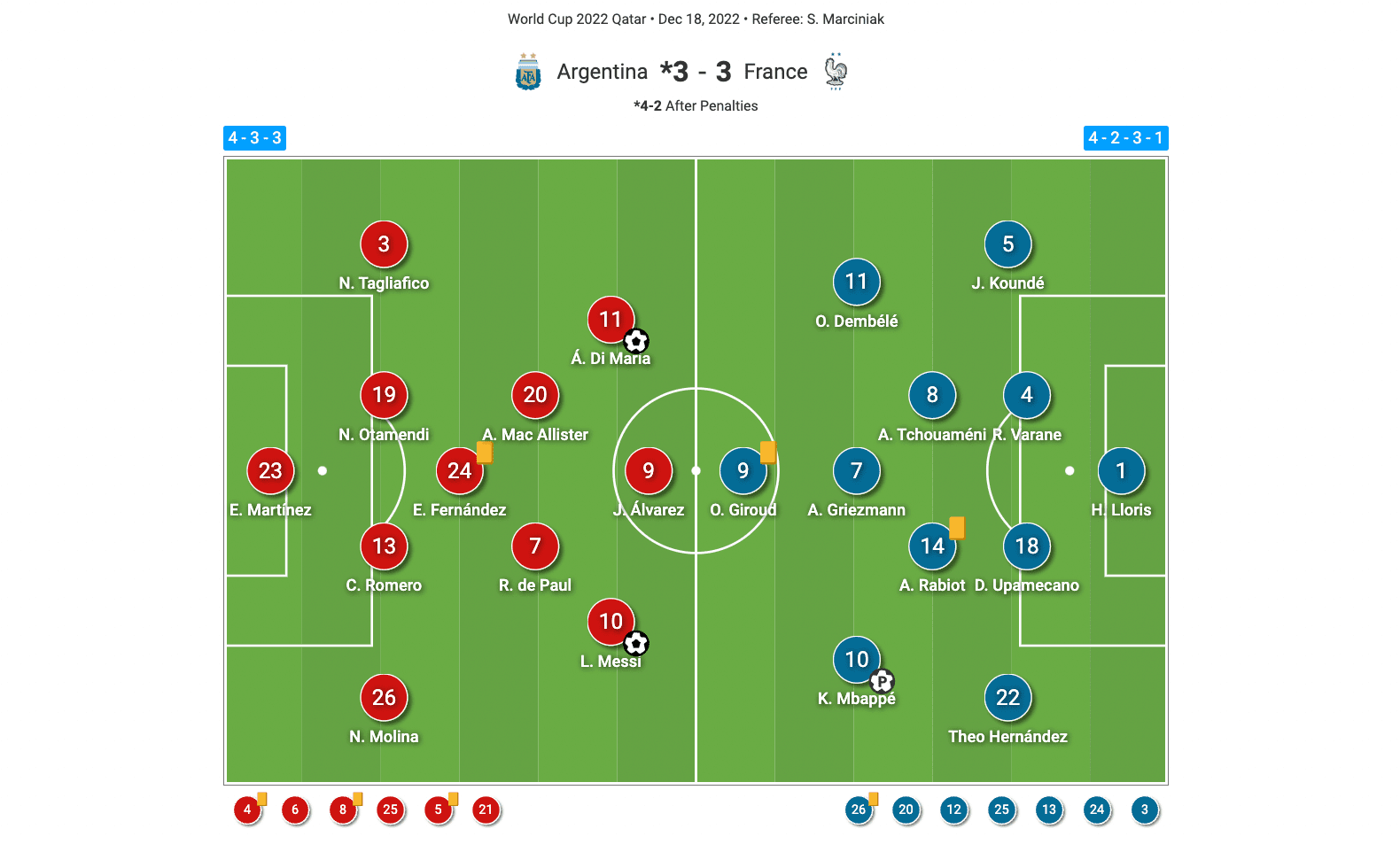
Let’s begin by running through the lineups for both sides. Starting with the new World Champions, Argentina, Lionel Scaloni lined his side up in a 4-3-3 shape for the majority of this game, and Aston Villa’s Emiliano Martínez started in goal for La Albiceleste behind a back four of right-back Nahuel Molina, right centre-back Cristian Romero, left centre-back Nicolás Otamendi and left-back Nicolás Tagliafico.
Enzo Fernández played at the base of midfield alongside his now-regular partners in right central midfielder Rodrigo De Paul and left central midfielder Alexis Mac Allister — we recently published an analysis piece looking specifically at this midfield trio and their individual roles here at Total Football Analysis, if you’d like to read more about them, titled: FIFA World Cup 2022: The tactical dynamics of Argentina’s menacing midfield – scout report.
Messi started on the right side of the attack but played quite a free role, as usual; he lined up alongside Manchester City’s Julián Álvarez, while Juventus’ Dí María completed the starting XI from the left-wing.
Scaloni made a grand total of six changes to his starting lineup over the course of this game. His first change came in the 64th minute as Marcos Acuña replaced Dí María on the left. Gonzalo Montiel then replaced Molina after 90 minutes; these were the only two changes Argentina made during normal time.
In extra time, they made two substitutions in the 102nd minute, with Leandro Paredes replacing De Paul and Lautaro Martínez taking over from Álvarez up front. Then, in the 116th minute, Germán Pezzella came on for Mac Allister before Argentina’s final substitution in the 121st minute saw Paulo Dybala take to the field in place of Tagliafico for the penalty shootout.
Moving on to France, Didier Deschamps lined his team up primarily in a 4-2-3-1 shape. Captain Hugo Lloris started in goal for Les Bleus behind a back four of right-back Jules Koundé, right centre-back Raphaël Varane, left centre-back Dayot Upamecano and left-back Theo Hernández.
Real Madrid’s Aurélien Tchouaméni started next to Juventus’ Adrien Rabiot at the base of France’s midfield, behind Ousmane Dembélé on the right-wing, Antoine Griezmann in the ‘10’ position and Mbappé on the left. Lastly, Olivier Giroud started up front for the 2018 World Champions.
Deschamps made one more change than Scaloni during the fixture, totalling seven substitutions. His first two substitutions came very early and were seemingly not forced by injury, but rather tactical decisions. In the 41st minute, Randal Kolo Muani came on for Dembélé while Marcus Thuram replaced Giroud up front.
France went on to make another couple of changes in the 71st minute as Kingsley Coman came on for Griezmann and Eduardo Camavinga took to the field in place of Hernández, deputising in an unfamiliar left-back role.
These were all the changes France made in normal time, but they went on to make three more in extra time. The first saw Monaco’s Youssouf Fofana replace an injured Rabiot after 96 minutes.
France’s next substitution was also forced through injury, as Varane came off for Ibrahima Konaté in the 113th minute. Lastly, France introduced Axel Disasi for Koundé 121 minutes into the contest, just in time for the penalty shootout.
Argentina’s build-up and ball progression
We’re going to start our tactical analysis by focusing on Argentina’s build-up play and ball progression, and how it was influenced by Mbappé of France. This is where we look at how Scaloni’s tactics capitalised on the biggest weakness Mbappé brings to his team amid an array of sublime strengths: his lack of defensive contribution.
Mbappé’s lack of defensive contribution and work rate is a hindrance to his team, there’s no hiding from it. Indeed, having Mbappé in your side gives you astonishing capabilities in possession and the possibility that the Frenchman will all of a sudden just make something happen out of nothing, as he did in this game. However, without the ball, he gives the opposition a big, big target to aim for.
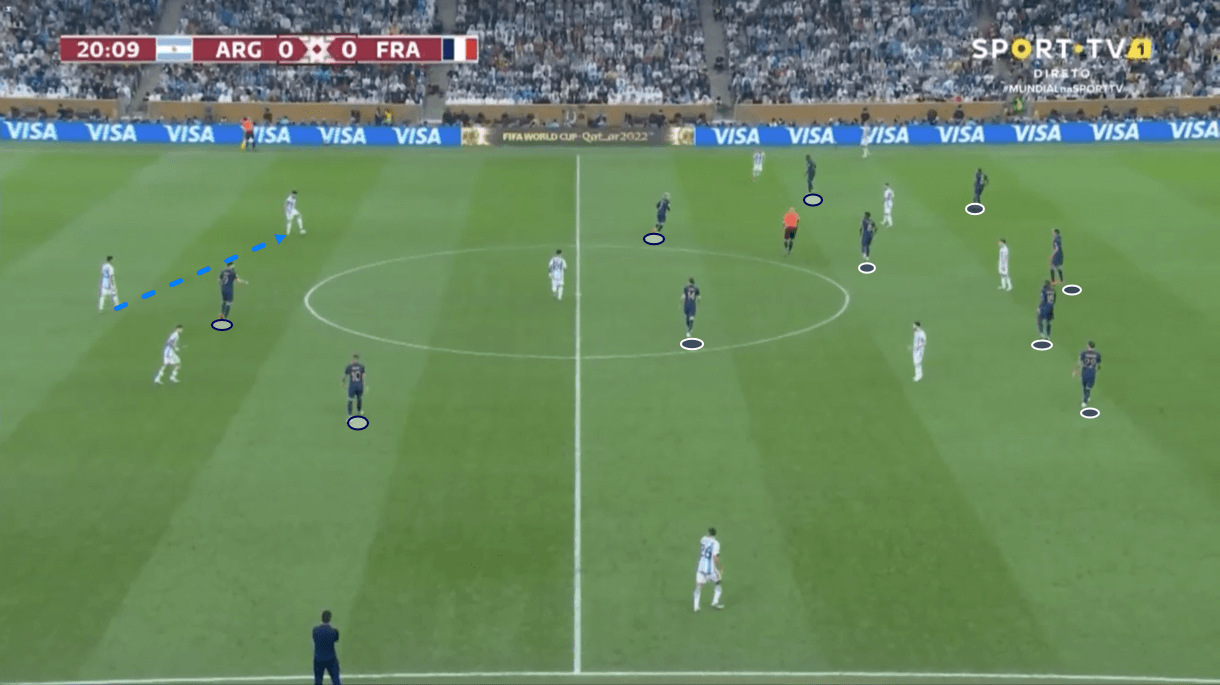
During the early portion of this game, Mbappé played on the left wing but he didn’t get back alongside the other midfielders to form a compact defensive shape. Instead, he preferred to stay high, aligning himself more with centre-forward Giroud than ‘10’ Griezmann and right-winger Dembélé.
This created a warped defensive shape that left major gaps in France’s left side, as figure 2 demonstrates (forwards, wingers and attacking midfielders are marked with a blue circle with a white interior while the midfielders and defenders are marked with a white circle with a blue interior).
With Dembélé positioned deep, the pass to the left centre-back was easy for Argentina, and with Mbappé positioned high, the pass behind him to the right half-space from that left centre-back offered easy progression for La Albiceleste.
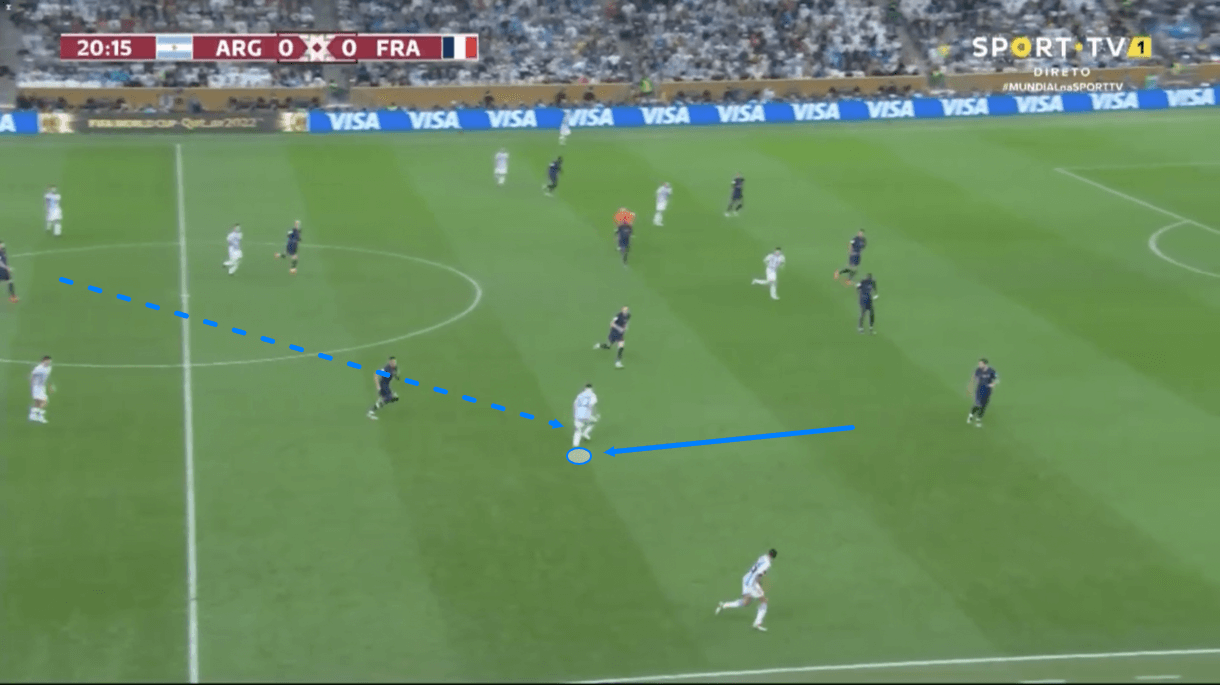
Adding to this the fact that Messi loved to occupy the right half-space and you had a major recipe for disaster in the French camp. Their defensive shape was terribly disorganised for about 40 minutes and allowed Argentina to completely dominate the first half, slicing through France time and time again, creating chance after chance behind left-winger Mbappé via the right half-space.
It wasn’t just Mbappé at fault here, France’s first line of pressure was too easy to play through during the first half in general, as figure 4 below shows four instances of. We had a plethora of examples to choose from, so here are four of the best.
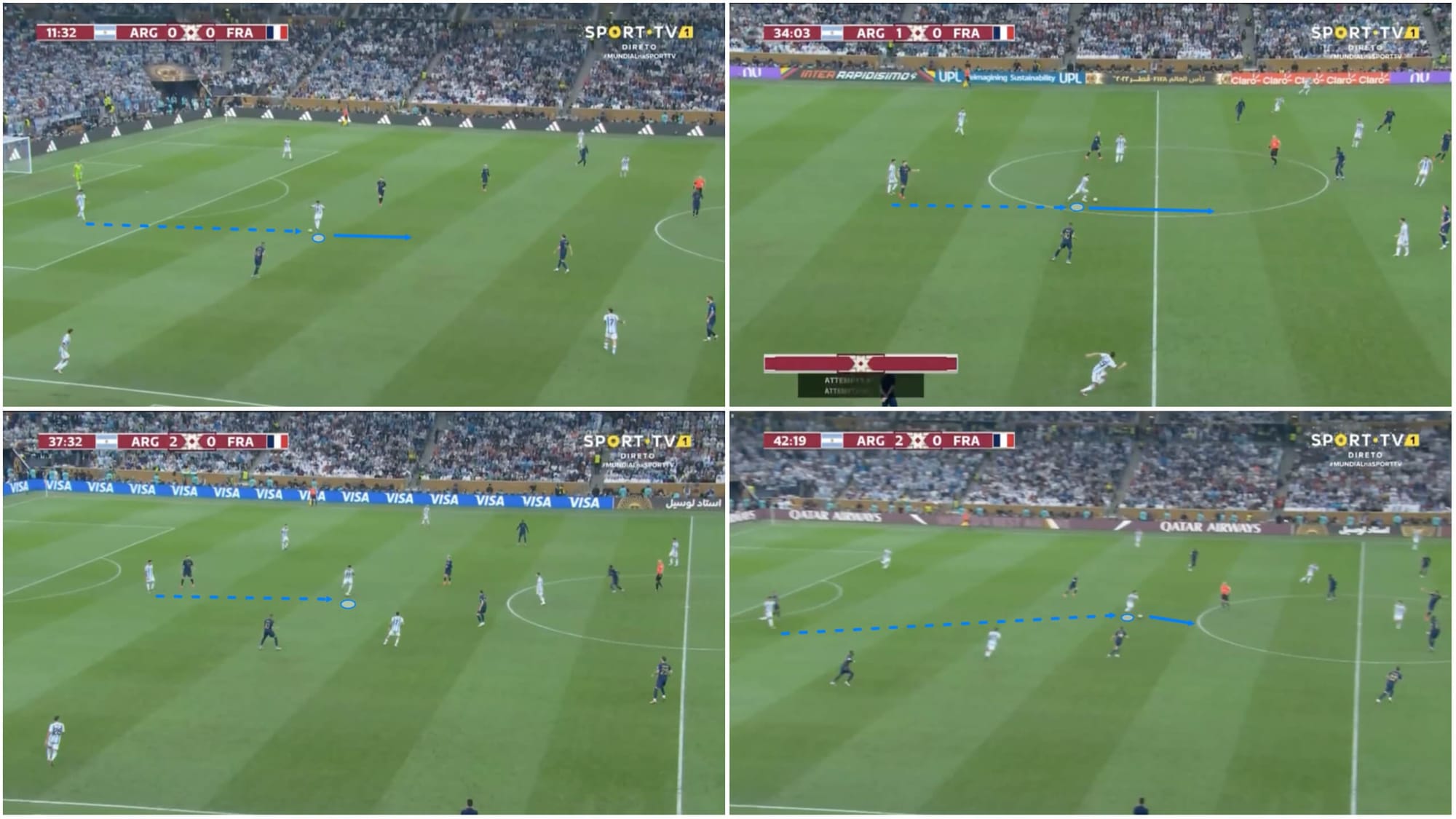
Giroud and Mbappé offered very little in terms of stopping Argentina from progressing from the backline to the midfield — and this was the job of the centre-forward in this team — they had to shadow the Argentinian holding midfielder and prevent them from receiving the ball. The French forwards failed to do this in Sunday’s game. Griezmann, the ‘10’, could’ve picked the player up but he was often pressing the backline more aggressively rather than marking the possible receiver who the centre-forward as meant to be keeping in their cover shadow.
At times, this led to a 4-2-4 shape that failed to block passing lanes through that first line. This left Tchouaméni and Rabiot completely exposed at times and, again, allowed Argentina to slice through France’s defensive shape on countless occasions during the first half. Given the state of France’s early defending, it’s no wonder Argentina cruised into an early two-goal lead.
The defensive work rate and energy from the French forward line were poor at times but they mainly seemed beaten down by countless failed pressing attempts by the end. The disorganisation killed them and their spirit in the early stages of the game. This led to Deschamps’ early change, swapping Dembélé and Giroud out for Kolo Muani and Thuram.
The purpose of this was to move Mbappé to the centre-forward position and have defensive energy on the wings that Giroud couldn’t provide. As for Dembélé, he simply had a poor game, misplaced lots of passes and touches, failed to provide enough energy to regain possession via the counterpress and ultimately helped Argentina to generate chances on the counter.
This change had nothing to do with France’s in-possession game — Mbappé is known to prefer coming off the left. However, his defensive deficiencies forced Deschamps’ hand to play him centrally and fix the awkward defensive shape.
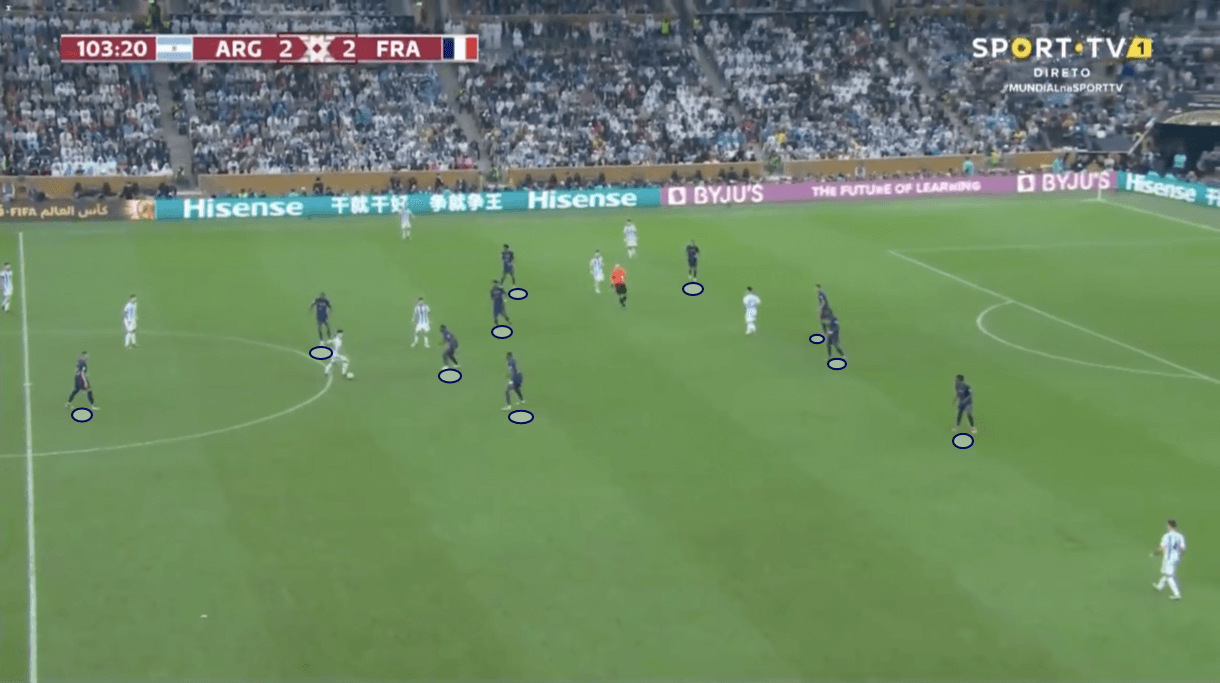
By the second half, France’s defensive shape was more respectable and remained so for the rest of the game. Kolo Muani and Thuram tracked back as you’d expect wingers to track back and organise themselves, creating more of a typical 4-4-1-1 shape without the ball, as figure 5 shows. After making these changes, Argentina had a much tougher time slicing through France and failed to score again until the second half of extra time, so perhaps Deschamps’ decisions were justified.
Argentina’s defensive approaches to controlling Mbappé
Of course, when in possession, Mbappé is an absolutely lethal player — he proved that in Sunday’s game. Still, it largely wasn’t Mbappé’s most effective performance.
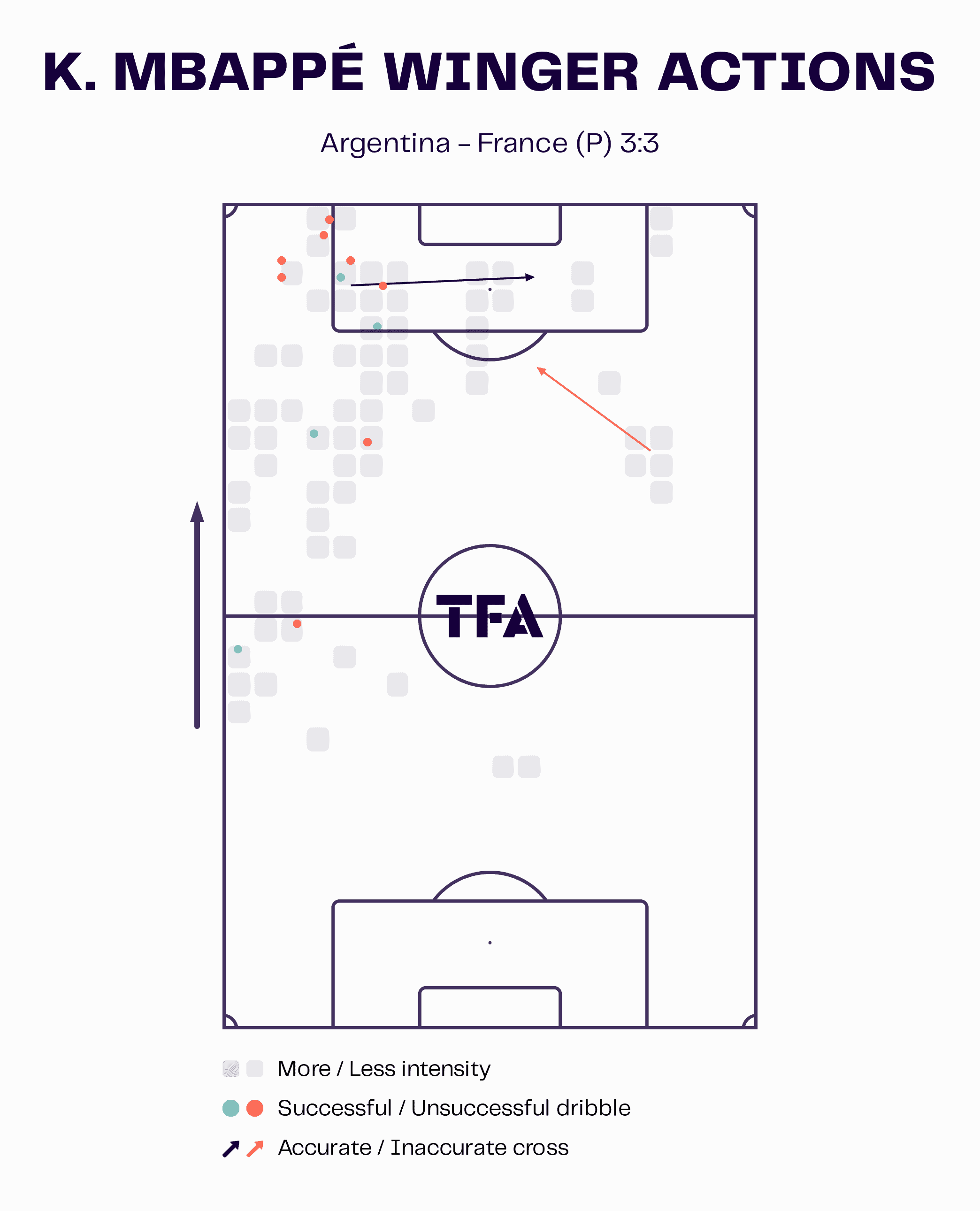
Indeed, Mbappé produced some mesmerising dribbles, especially later on in the game versus tired Argentinian legs, some really enticing crosses that almost set up what would’ve been certain winning goals, a moment of magic to score France’s second goal of the game and demonstrated unwavering confidence to score his two penalties. However, as figure 6 shows, the attacker had a lot of unsuccessful dribbles too.
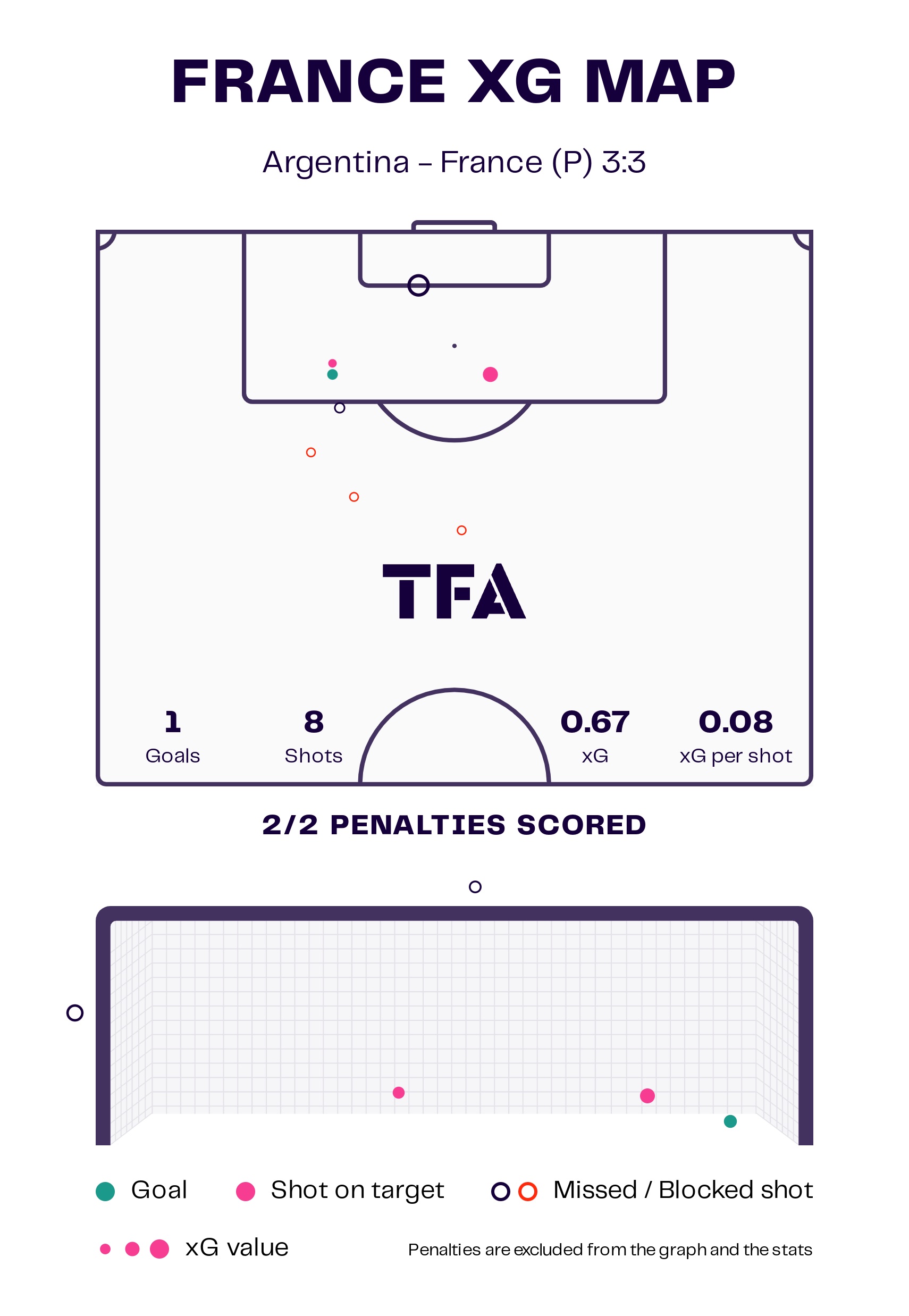
Furthermore, as France’s star attacker, he can’t be pleased to have seen his side generate a total of just 0.67 non-penalty xG over the course of the World Cup Final (just 0.08 non-penalty xG per shot).
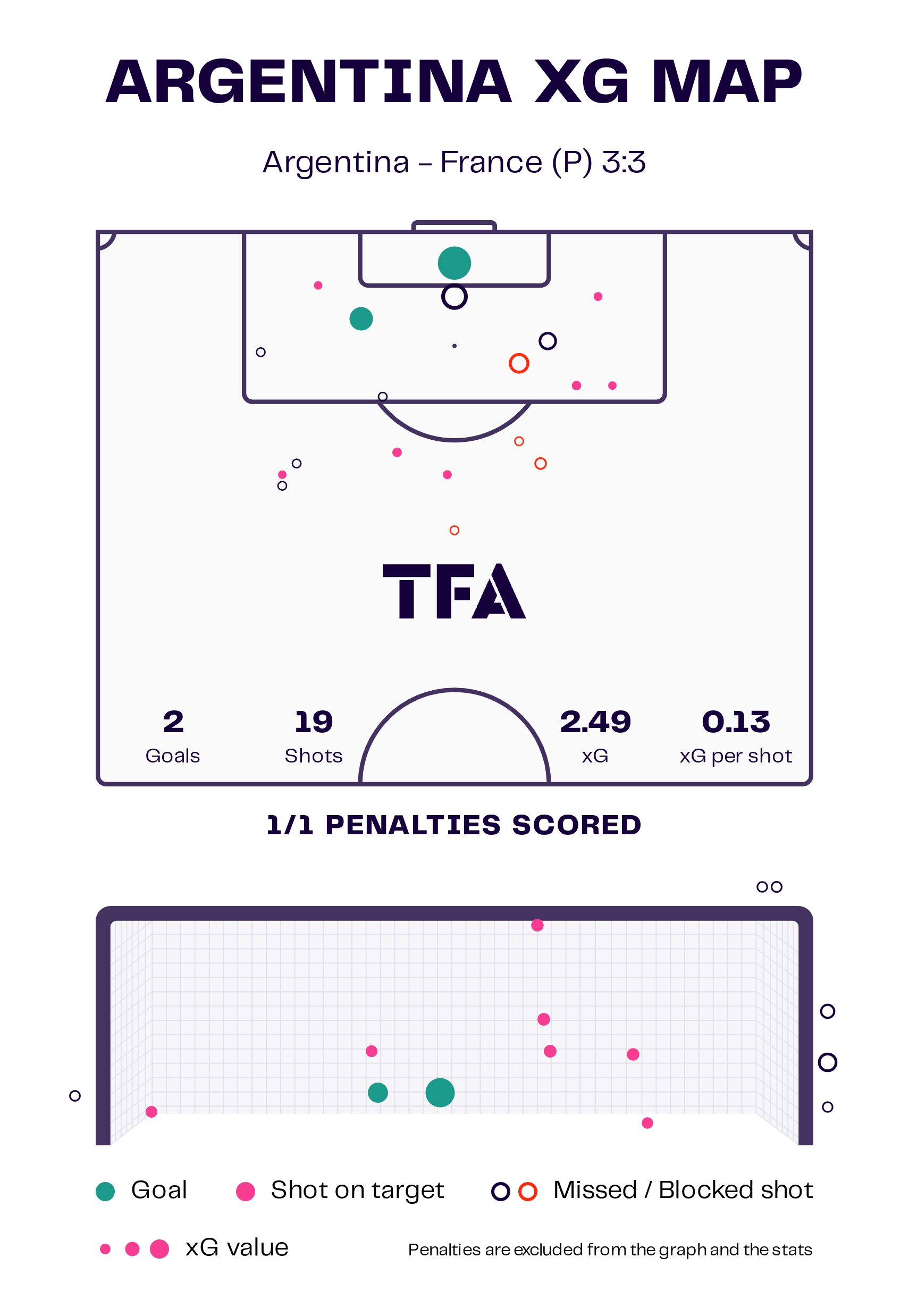
Compare this, really quickly, to Argentina’s non-penalty xG map in figure 8, and we can see very clearly which team was on top in this game and ultimately created enough chances to say they really deserved to come away with the win.
But Mbappé wasn’t just ‘bad’ — he demonstrated that he’s one of world football’s brightest stars in Sunday’s game. So, why was his performance in general so subdued? The answer lies in Argentina’s defensive approaches to controlling him depending on the situation.
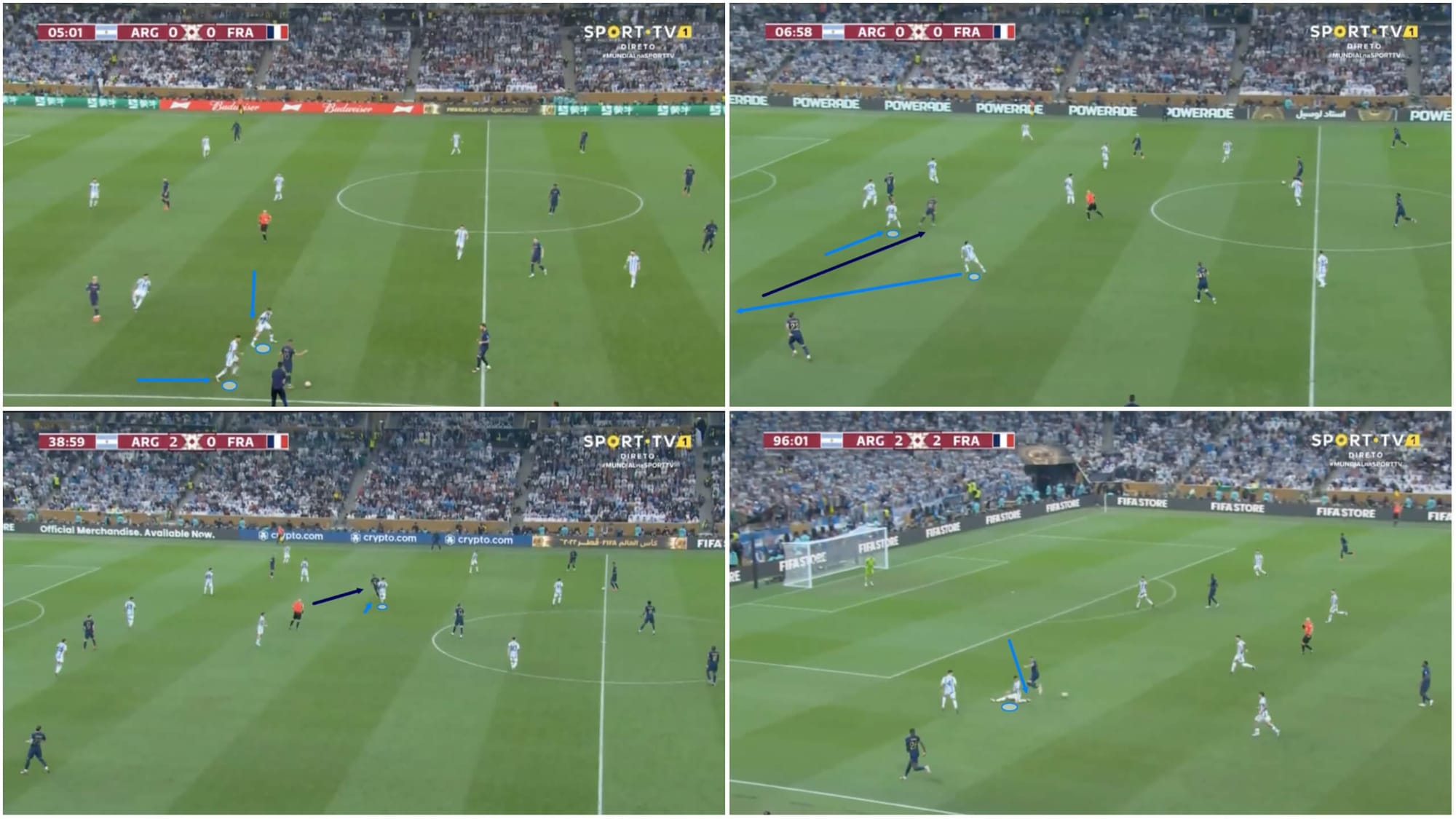
As figure 9 shows, Argentina took different approaches to dealing with Mbappé depending on how and where he moved. They had seemingly prepared for all possible movements from the electric attacker.
Early on, when Mbappé was stationed out wide, it was common to see Argentina double-up on him in their mid-block, allowing France’s left-back to be free and putting both Molina and De Paul on Mbappé.
Mbappé started to drift inside as the game wore on and to an extent, Molina had license to man-mark him as he came inside, resulting in another Argentinian player, like De Paul here in the top-right quadrant, dropping out to the right-back position to cover for Molina while he was away on Mbappé duty.
Molina wouldn’t man-mark the 23-year-old all over the pitch, however. Argentina’s players always had the responsibility of passing their man off to another player as they entered their zone, provided that possibility was on and the transition was relatively seamless. In the bottom-left quadrant, we see holding midfielder Enzo Fernández man-marking Mbappé, who’s moved across from the left wing to more of a right central midfield position.
Lastly, it was common to see Argentina’s players defending very aggressively on Sunday to cut out balls played into Mbappé before they arrived or just to prevent the 23-year-old from turning to face their goal in a dangerous position. We see an example of this in the bottom right quadrant above.
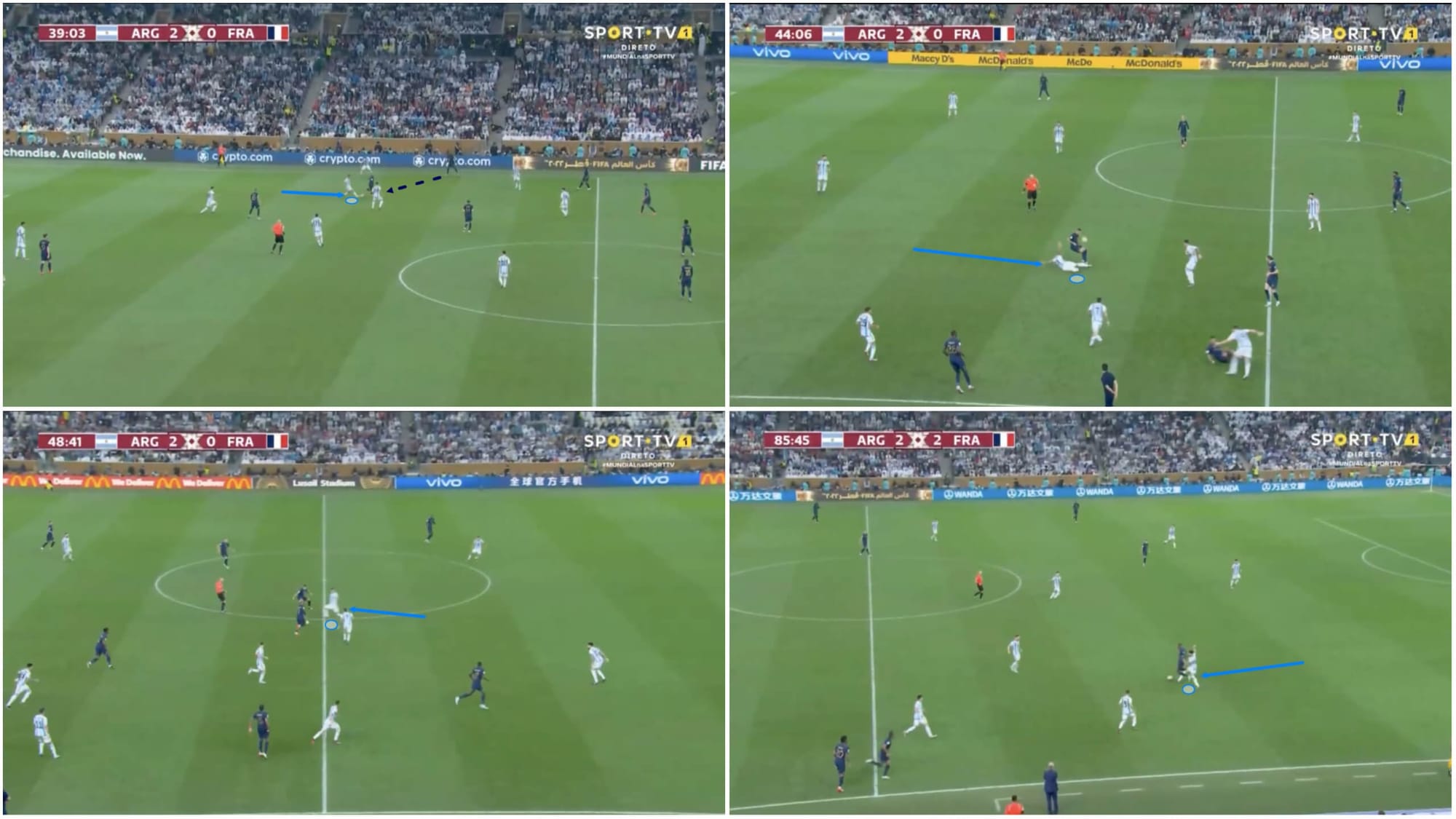
It wasn’t just Mbappé who Argentina defended aggressively against — they set up to defend aggressively against all balls played into any member of the French front four’s feet — even if they dropped off into deeper areas. Generally, Mbappé didn’t drop too deep and preferred to wait for the ball to arrive, which left gaps open for Argentinian defenders to jump in and cut out the balls played into the 23-year-old.
In the 2022 FIFA World Cup, Argentina made an average of 41.14 interceptions per 90, but in this game, they made 63 interceptions. They also made 27 fouls, almost twice as many as their tournament average of 14.71 per 90.
Their aggressive defensive approach, with centre-backs, midfielders and full-backs frequently stepping out to shut down attacks abruptly when the ball was sent into attackers’ feet was very effective at limiting France’s time on the ball in high-value areas and the French attackers struggled to cope with Argentina’s aggressive defending. The Argentinians were well prepared for the task at hand, knew the French attackers and their preferences well and made plenty of well-timed interceptions to cut down their attacks.
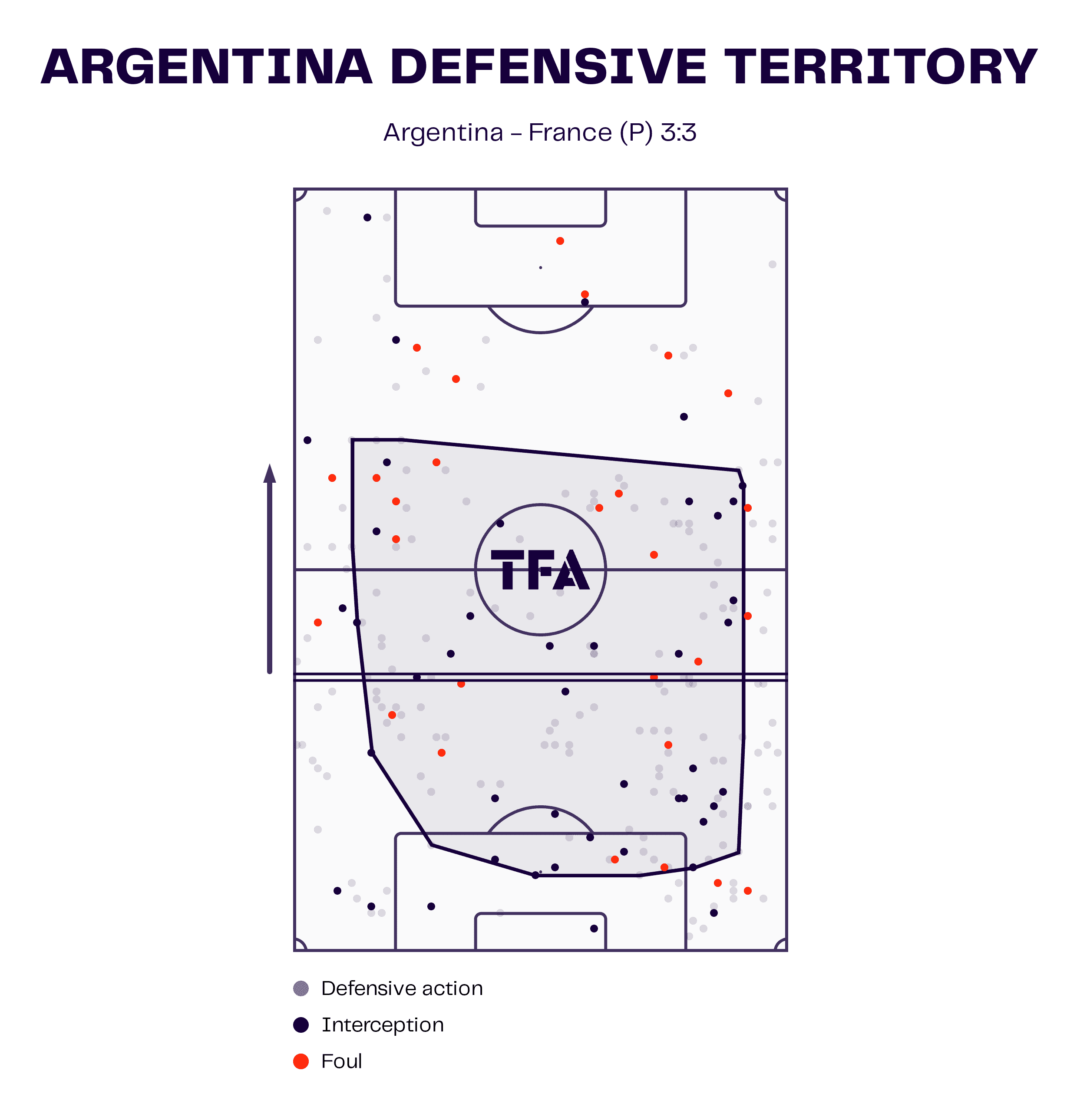
Additionally, Argentina were well prepared to give away fouls; they mostly gave away tactical fouls to shut down French counterattacks before they advanced to a dangerous stage, which is another way in which they controlled Mbappé as the 23-year-old thrives in transition with space to burst away into. This also prevented France from generating much momentum, as Argentina were always comfortable with breaking the game up via fouls and making it a stop-start affair for lengthy periods.
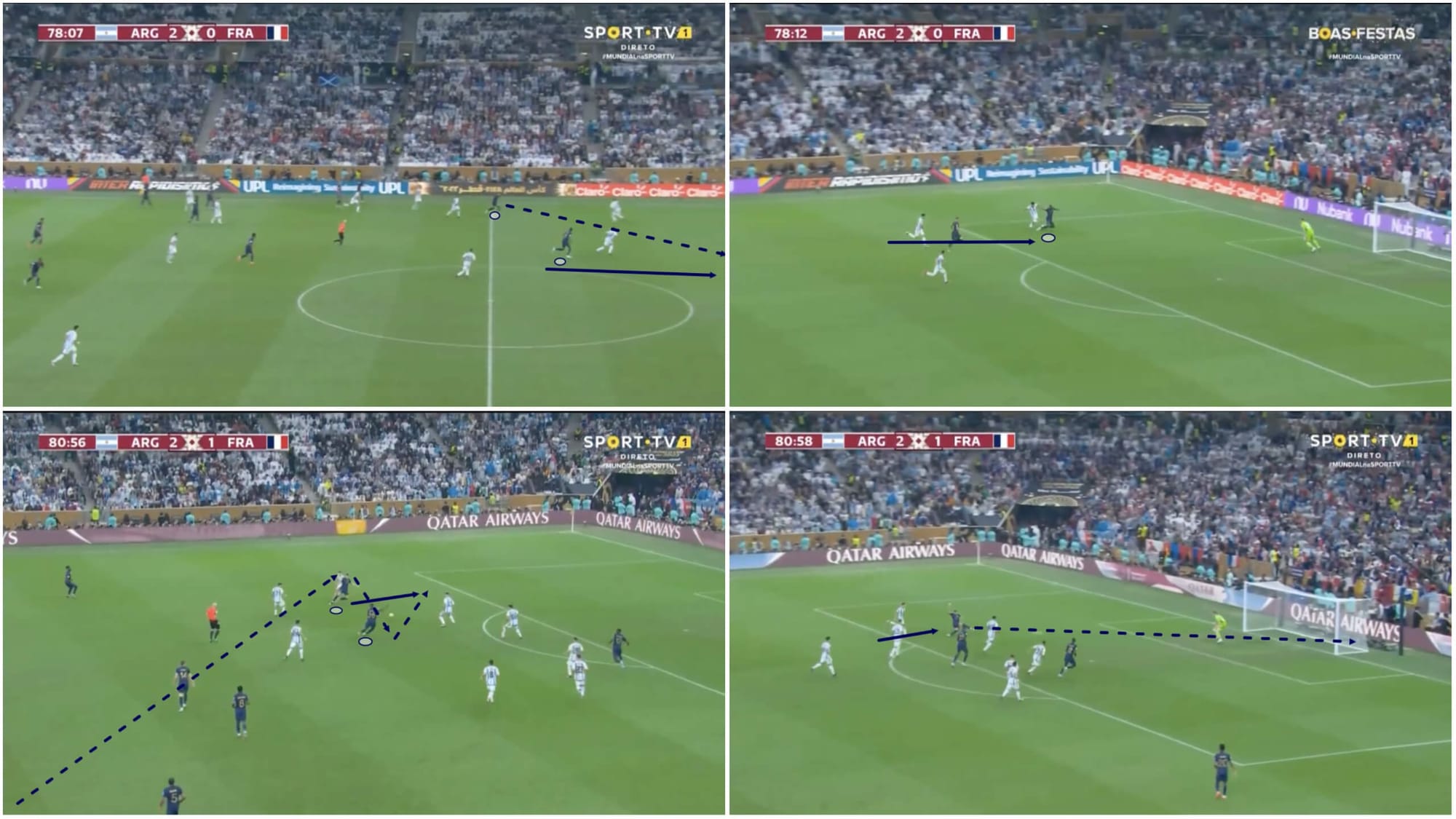
France’s first two goals — the top half of figure 12 showing the lead-up to the first penalty they were awarded and the bottom half showing Mbappé’s remarkably-struck second goal — came from two situations when they failed to execute their plans as well as they generally did throughout the contest and, instead, France’s game plan came off.
Firstly, in the top half, we see a France counterattack that Argentina couldn’t cut down or foul their way out of in time, as the ball dropped just in front of Mbappé who did amazingly well to get there in time to scoop it over the top for Kolo Muani to chase down and win the penalty.
Meanwhile, in the bottom half, we see Mbappé play a one-two with Thuram, turn and get in behind the defensive line to get a clear sight of goal. This is the type of chance France had been trying to engineer throughout the game to no avail due to Argentina’s excellent defending, either via their aggressive approach cutting out the ball to Mbappé in the first place as we’ve already seen or, as we see in figure 13, by being prepared for Mbappé’s tendency to sprint away into space and getting a head start on him.
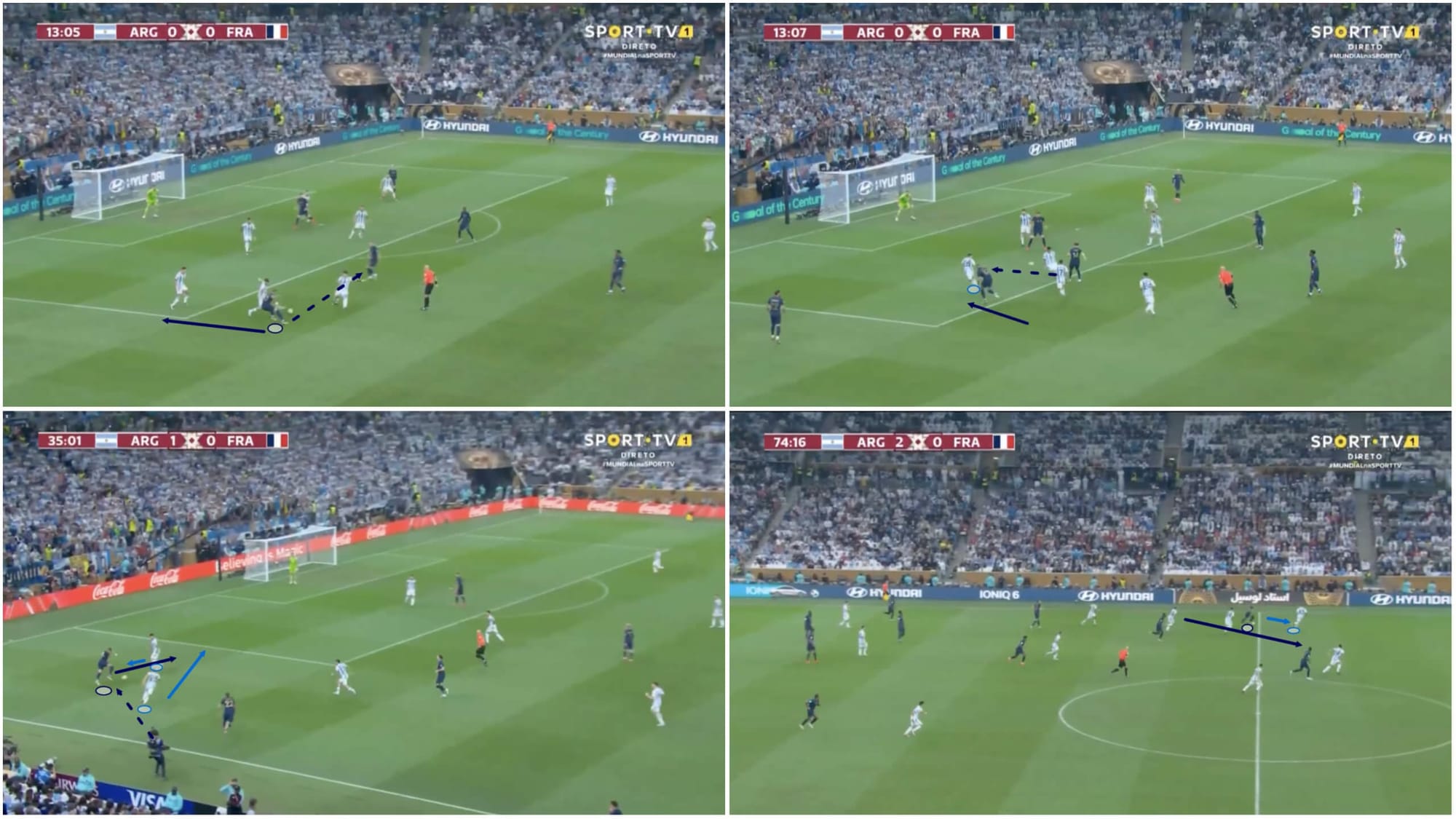
The top half of this image shows another example of Mbappé trying to pull off a one-two in behind the Argentinian defence similar to what happened when he scored France’s second goal of the game.
However, on this occasion, the Argentinian right-back dealt with the situation well by turning early and sprinting back while getting his body between Mbappé and the ball, ensuring that the pacey 23-year-old doesn’t catch him standing square to leave him as a sitting duck.
The example in the bottom left quadrant shows Mbappé turning on the ball trying to get behind Argentina’s defence to attack the box but the full-back is there to sprint back while his teammate pushes Mbappé wide, buying the full-back time to get back in front of the PSG man and, again, shepherd the ball to safety.
In the last example, in the bottom right quadrant, we see Mbappé again receiving on the half-turn and looking to take the ball in behind Argentina’s defence, but the Argentinian right-back is aware of the attacker’s intent, turns his body side-on early and starts running backwards, giving Mbappé no space to run away into, really.
For the majority of Sunday’s contest, Argentina executed these tactics really well and while they did end up getting punished for not getting it right every time, they did enough to get their hands on the trophy, in the end, which is what counts.
Argentina’s counterattacks
The final section of our tactical analysis piece looks at Argentina’s counterattacks and how they ended up being crucial to La Albiceleste’s victory over France. Over the course of the World Cup tournament, Argentina averaged 2.57 counterattacks per game. In Sunday’s game, they had five counterattacks. Additionally, two of their three goals came at the end of a transition to attack, so counterattacks were absolutely key to Argentina’s victory on Sunday.
Again, Argentina capitalised on Mbappé’s weaknesses in defence here. While he wouldn’t offer much without the ball or really track back to help his team defend in transition, Argentina had Messi on his side at the other end, ready to receive the ball in space and pounce on the opportunity to drive at France’s unprepared defence on the counter, which we saw on several occasions in the World Cup Final.
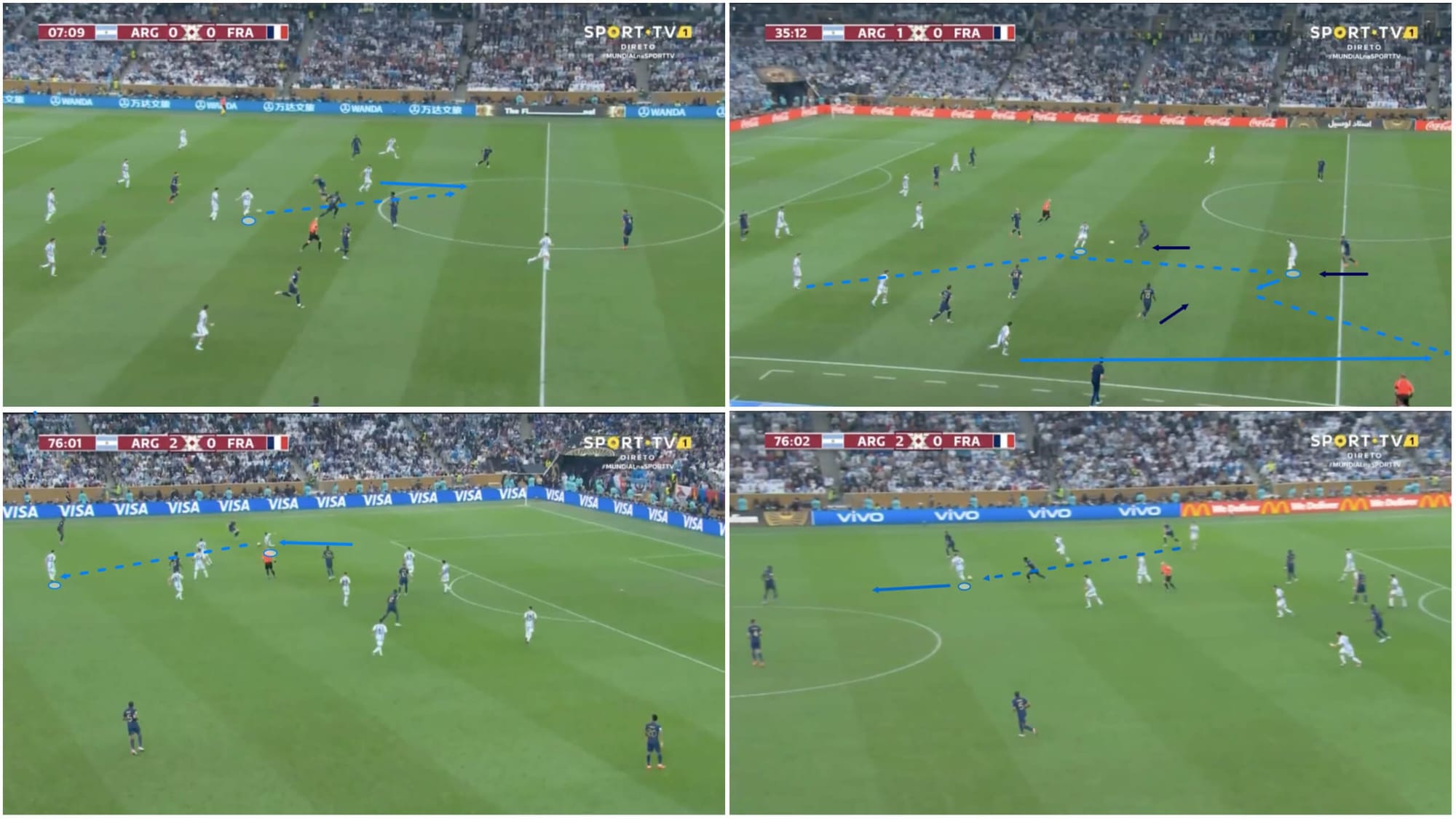
Messi managed to get on the ball in loads of space in midfield time and time again as Argentina transitioned from defence to attack versus France. The first example in figure 14 in the top-left quadrant shows Messi receiving deep, in front of France’s midfield line and just behind their forward line, as they begin a transition to attack after regaining the ball in their mid-block. Messi is always on the lookout for space on the pitch and tries to occupy areas where no one else is found, which is how he got on the ball in lots of space centrally in this example.
From here, the magician can slice the ball through France’s midfield line and send his marauding teammates through to attack Les Bleus’ weakened, underloaded backline.
The top-right quadrant shows the build-up to Argentina’s second goal — a fluid, quick passing one/two-touch move that saw La Albiceleste rocket from their half of the pitch to France’s while knocking the ball around too quickly for France’s defence to catch up. In this move, as was the case with a couple of the other fluid counterattacking moves we witnessed in Sunday’s game, Argentina were a step ahead of their opponents for the entire time, and the defensive side was constantly playing catch-up with their reactions and decision-making. As a result, Argentina easily cut them open, with Messi playing a key role in creating Di María’s goal here.
In the bottom two quadrants, we see another example of Messi receiving in loads of space just behind the opposition’s midfield line and in front of their backline. Giving the Argentinian talisman so much space in dangerous areas on the counter over and over again was asking for trouble from France and it’s no wonder Argentina had so much joy in transition on Sunday when we look at these examples of the space Messi was able to find and in which his teammates were able to find him.
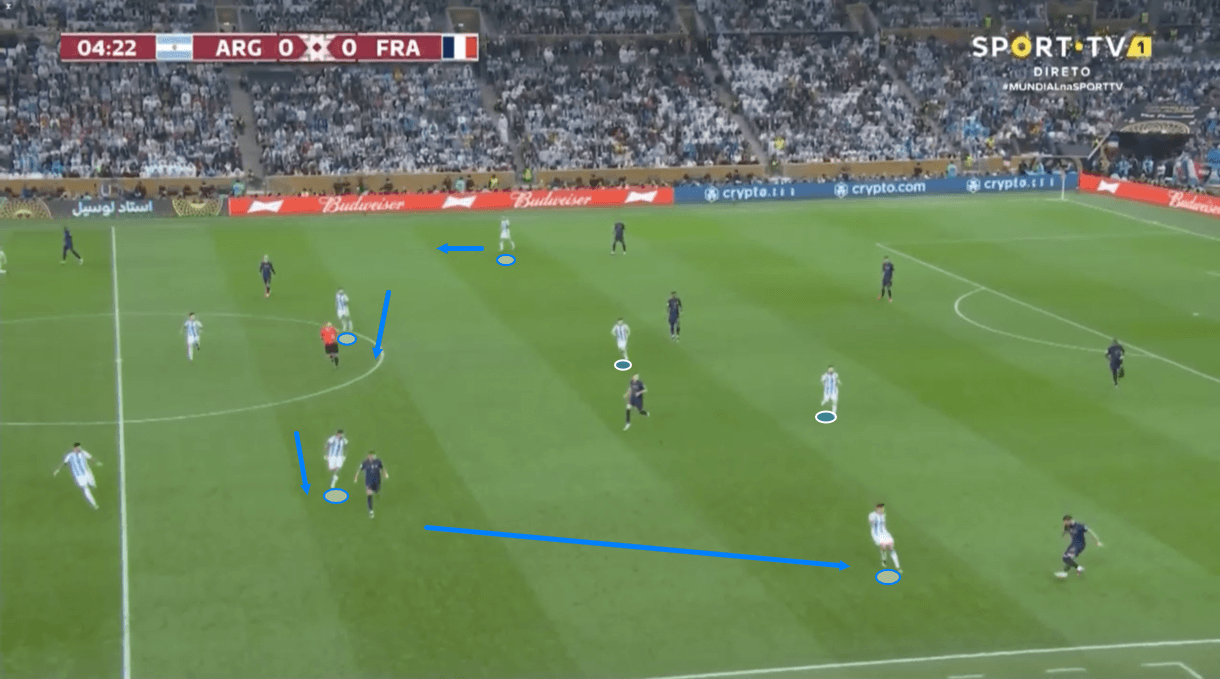
Argentina’s wide midfielders enjoyed the freedom to leave the central zones and move out wide to press the opposition full-back, as we see De Paul doing in figure 15 above. Theo Hernández didn’t deal with this well and ended up making a couple of bad passes in sensitive areas that allowed Argentina to counterattack from very good positions too.
La Albiceleste’s pressing was a contrast to France’s in terms of organisation, as soon as one player, like De Paul here, jumped out, the others were already covering. It was like clockwork. This kept everything safe and under control, meaning no easy gaps as a result of De Paul’s movement could be exploited and the Atlético Madrid man could press with bravery and fearlessness, forcing turnovers in dangerous areas for his side to capitalise on.
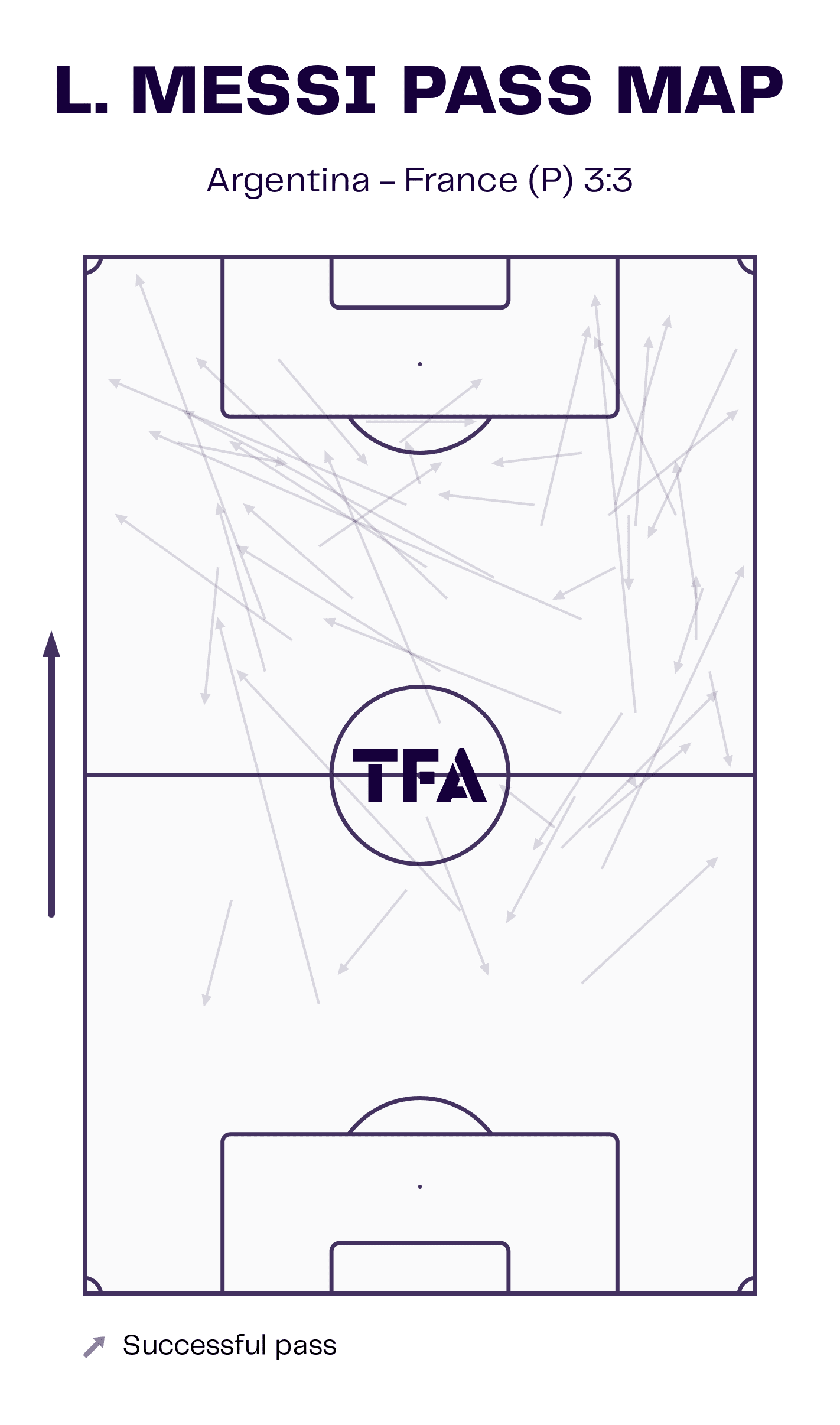
Lastly, we can see Messi’s pass map from this fixture in figure 16. Of course, he didn’t just remain in the right half-space area — he roamed around quite a bit, but we can see he enjoyed a lot of playmaking opportunities from this right half-space position where he was afforded so much space on several occasions. He varied up his passes, not always going long or short, not always going to the left or to the right. This unpredictability made it even more difficult for the opposition to defend against the Argentina captain.
Conclusion
To conclude this tactical analysis piece, we hope it’s clear from our analysis how Argentina approached the game tactically to neutralise Kylian Mbappé and exploit his weaknesses to expose France. The successful implementation of these tactics helped Argentina to create far more high-quality chances than France in this game, and gave them as good a chance as possible of taking home the trophy.
In the end, the game went to penalties as a result of some Mbappé magic and luck but this was definitely Argentina’s night and a deserved win based on the team’s performance and excellent execution of Scaloni’s plan.





Comments